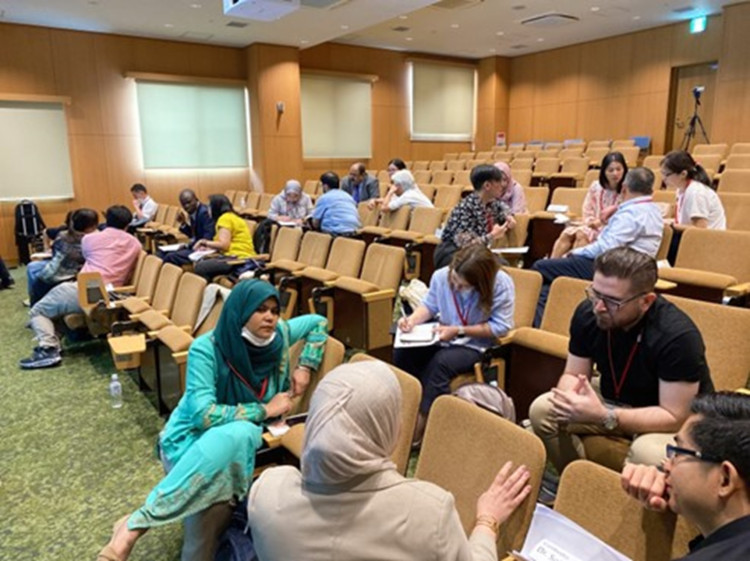In a significant step towards advancing nuclear medicine capacities to address a growing global burden of non-communicable diseases, the International Atomic Energy Agency (IAEA), in collaboration with Japanese experts, recently carried out its first regional training on theranostic techniques for medical professionals from 15 Asian countries.
The training, part of IAEA's Rays of Hope initiative to expand cancer care, was held from 5 to 9 August 2024 in Kanagawa, Japan, in collaboration with the Shonan Kamakura General Hospital (SKGH) - a member of the Consortium of Universities and Institutions of Japan (CUIJ) and a Rays of Hope Anchor Centre.
Theranostics is an innovative field of personalized, precision medicine that brings together diagnostic imaging and targeted therapy to treat cancer and other non-communicable diseases. It uses radiopharmaceuticals to precisely reach cancer cells and destroy them, sparing healthy tissues as much as possible.
The combined approach can lead to shorter treatment times, improved outcomes for patients, and more efficient use of healthcare resources. While the field is evolving, access to the necessary technology and expertise remains limited in some parts of the world. A recent IAEA-led Lancet Oncology Commission on Radiotherapy and Theranostics highlighted the need for further investment and training to fully realize the benefits of the approach for more patients.
"Theranostics is a highly advanced and promising approach, and we are glad to share our expertise and facilities with experts from across the region to foster better cancer management," said Dr. Shuzo Kobayashi, Chief Executive Officer of SKGH, who led in the organization of the event.
From Theory to Practice

Participants with Prof. HATAZAWA Jun, Focal Point of CUIJ, and Secretariat of the Regional Training Course. (Photo: S.Matsumoto/SKGH)
The five-day course offered a mix of theoretical lectures delivered by IAEA and Japanese experts and site visits. Topics covered the chemical and physical properties of radiopharmaceuticals, dose calculation for targeted therapies, clinical management of prostate cancer and neuroendocrine tumours, which are particularly suitable for the application of radiopharmaceuticals. They also received an overview of advancements in the field of boron neutron capture therapy (BNCT), a neutron-based technique showing promise as a treatment option for certain cancers.
Participants had the unique opportunity to visit cutting-edge nuclear medicine facilities at SKGH. This included a ward dedicated to the administration of Lu177 Dotatate (a radiopharmaceutical for the treatment of neuroendocrine tumours), the Shonan Health Innovation Park and the proton beam and BNCT facilities. The visits allowed participants to observe state-of-the-art nuclear medicine technology in practice and to explore how these innovations could be applied in their home countries. "Our goal was to ensure that participants not only gain theoretical knowledge but also see first-hand how these technologies are implemented in clinical settings," explained Francesco Giammarile, nuclear medicine physician and IAEA technical officer.
Participants gained insights into modern nuclear medicine, and many expressed how the techniques and protocols learned would be instrumental in improving their own clinical practices, particularly in the application of 177Lu-labelled radiopharmaceuticals.
Fostering Collaborative Learning

Participants engage in a group discussion during the Regional Training Course on 9 August 2024. (Photo: S.Matsumoto/SKGH)
The course promoted substantive discussions among participants, including on the challenges and opportunities for applying theranostics in their respective countries.
"The workshop was an enriching experience. I had the opportunity to see and visit facilities with latest technology which are engaged in management and therapy of cancer patients, and left feeling more empowered and equipped to handle current and future challenges," said Batool Essa Albalooshi from the Dubai Health Authority, United Arab Emirates.
She highlighted the value of group discussions and of the course's interdisciplinary approach, which brought together experts in radiopharmacy, endocrinology and nuclear medicine. "I carried some solutions and ideas to apply at work to enhance the daily practice and improve therapy planning," she said.
The training underscores the IAEA's commitment to advancing nuclear medicine technology in Member States and highlights the importance of international collaboration in the fight against cancer and other chronic diseases.
As part of the ongoing collaboration with CUIJ Japan, and with the support of the IAEA's technical cooperation programme, additional courses are planned under the Rays of Hope initiative to extend capacity building activities in diagnostic nuclear medicine, radiology and radiopharmaceutical therapy to other regions.
This article covers one of the many topics that will be discussed during the 2024 Ministerial Conference on Nuclear Science, Technology and Applications and the Technical Cooperation Programme






